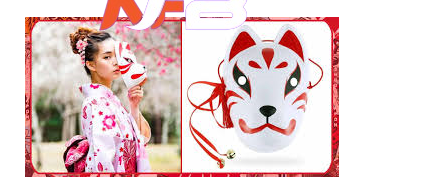Masks have long been revered as symbols of culture, tradition, and artistry, serving as tangible representations of the human experience across the globe. In this exploration, we delve into the captivating worlds of Japanese and Western masks, tracing their historical origins, intricate designs, and cultural significance. Join us on a journey as we compare and contrast these two rich traditions, uncovering the nuanced differences and shared artistic expressions that have captivated audiences for centuries.
Read Also :- Decorate Backyards For The Fall-Winter Season

Historical Origins
Japanese Masks:
With roots dating back to ancient theatrical performances, Japanese masks hold a revered place in the country’s cultural tapestry. From the solemn expressions of Noh Theater to the vibrant characters of Kabuki, these masks embody centuries of artistic tradition and spiritual reverence.
Western Masks:
In contrast, Western masks find their genesis in the vibrant traditions of ancient Greece and the colorful festivities of European carnivals. From the exaggerated features of Greek theater masks to the elaborate disguises of Venetian masquerades, Western masks reflect a kaleidoscope of cultural influences and artistic expression.
Design and Aesthetics
Japanese Masks:
Crafted from materials such as wood, paper, and lacquer, Japanese masks are renowned for their meticulous craftsmanship and symbolic imagery. Each line and contour is imbued with meaning, capturing the essence of characters both mythical and mundane.
- Oni Masks
Oni masks are special masks from Japan that look like scary monsters with big eyes and sharp teeth. People wear them during festivals to scare away bad spirits and bring good luck. They’re part of old stories about good versus bad in Japan.
- Kitsune Masks
Kitsune masks are masks from Japan that look like foxes, which are important animals in Japanese folklore. These masks have long ears and a pointy nose, and they’re often used in traditional performances and festivals. In Japanese stories, foxes are believed to have magical powers, and wearing these masks is a way to honor and connect with that mystical tradition.
- Samurai Masks
Samurai masks, also known as “menpo,” were worn by Japanese warriors called samurai to protect their faces during battles. These masks had intimidating designs with fierce expressions and were often made from materials like metal or leather. They were an essential part of a samurai’s armor, not only providing protection but also striking fear into their enemies. Today, samurai masks are admired for their craftsmanship and are sometimes used in cultural events or as decorations to celebrate Japan’s rich history.

Western Masks:
In the Western tradition, masks come alive with a riot of colors, textures, and embellishments. Whether adorned with feathers, sequins, or intricate patterns, Western masks dazzle the eye and ignite the imagination, inviting wearers and viewers alike to partake in the magic of disguise.
- Greek Theater Masks
Greek theater masks were used in ancient Greece by actors to help them play different characters on stage. These masks were made from materials like linen, wood, or clay and had exaggerated features to show emotions like happiness, sadness, or anger to the audience. They were an important part of Greek theater because they helped the audience understand the story and the characters better, even if they were sitting far away.
- Venetian Masquerade Masks
Venetian masquerade masks are fancy masks worn at parties in Venice, Italy, called masquerade balls. They’re really pretty, with feathers, jewels, and fancy patterns. People wear them to hide who they are and have fun at the party, dressing up in cool costumes. These parties are a chance for everyone to dance, talk, and feel like they’re in a fairy tale.
Discover Masks That Reflect Your Unique Style at Japanese Oni Masks
Step into a world of cool masks that show off your style at Japanese Oni Masks! Our Japanese Oni Masks come in all kinds of designs, from traditional to modern. Whether you like scary faces or bright colors, we’ve got the perfect mask for you. Find your favorite and show off your unique style with Japanese Oni Masks from our store. Check them out now and see which one speaks to you!
Cultural Significance
Japanese Masks:
From sacred rituals to theatrical performances, Japanese masks play a central role in the country’s cultural landscape. Whether donned by performers or displayed in shrines, these masks serve as conduits between the spiritual and earthly realms, channeling the energies of gods and ancestors alike.

Western Masks:
Similarly, Western masks hold sway over a myriad of cultural celebrations and traditions. From the ghoulish delights of Halloween to the opulent extravagance of masquerade balls, Western masks embody the spirit of revelry, allowing wearers to shed their inhibitions and embrace new identities with each fleeting moment.
Read Also :- How to find the best Vue.js development services
Influence and Global Appeal
Masks are loved all over the world, bringing people together with their beauty and mystery. They’re not just for one culture—they’ve traveled far and wide, inspiring art, fashion, and fun everywhere.
- Sharing Ideas:
Sharing ideas about mask-making brings together the best of different cultures, creating beautiful blends of styles and techniques. For instance, Japan’s minimalist Noh masks have influenced Western theater, while the ornate masks of Venice inspire designers worldwide, showing how creativity knows no borders.
- Art and Fashion:
In the world of art and fashion, kitsune masks are not just accessories—they’re statements of creativity and culture. Artists use masks to explore identity and tradition, while designers incorporate them into haute couture and avant-garde collections. From the runway to the gallery, masks inspire awe and admiration, showcasing the endless possibilities of human expression.
- Movies and Plays:
In movies and plays, masks play a vital role in bringing characters to life and captivating audiences. Whether it’s the mysterious allure of a Venetian masquerade or the fierce expressions of ancient Greek tragedy, masks add depth and emotion to storytelling. From Hollywood blockbusters to intimate theater productions, masks transport viewers to new worlds and evoke a range of emotions, making every performance unforgettable.
- Celebrations Around the World:
Masks light up celebrations worldwide, adding color and excitement to festivals and parades. From the vibrant carnivals of Brazil to the solemn rituals of indigenous cultures, masks are symbols of tradition and joy that bring communities together in celebration. They embody the spirit of cultural heritage and unity, creating unforgettable experiences for people of all ages and backgrounds.
- Masks in the Digital World:
In the digital world, masks take on new life as fun and creative tools for self-expression. From Snapchat filters to virtual reality experiences, masks allow users to transform their appearance and interact with others in playful ways. They’re a modern twist on an ancient tradition, bringing the magic of masks to the digital age and connecting people across the globe through shared experiences and shared smiles.
In short, masks are more than just decorations—they’re a language of creativity and connection that everyone can understand, no matter where they’re from.
In the grand tapestry of human expression, masks stand as silent sentinels, bearing witness to the myriad hues of the human experience. From the hallowed halls of Japanese theaters to the bustling streets of Western carnivals, these masks serve as mirrors, reflecting the beauty, the tragedy, and the ineffable wonder of life itself. As we celebrate the rich traditions of Japanese and Western masks, let us embrace the diversity of human creativity and the boundless possibilities that lie beyond the masks we wear.










Leave a Reply